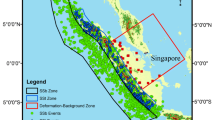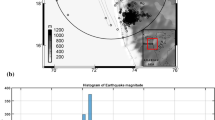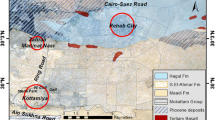Abstract
Muğla Province, which has been selected as the study area, is located in the Aegean Extension Region (AER), where seismic motions are widely observed. Moreover, the AER is the most active part of the Eastern Mediterranean Region in terms of seismic activity, and this seismicity has been continuing increasingly. This study aims to determine the seismic hazard of Muğla Province and its surroundings by using the probabilistic seismic hazard method. The earthquake dataset including 19,824 seismic records that were used in the research was obtained from the national and international earthquake catalogs. The data about the active fault zones in the study area were acquired from the General Directorate of Mineral Research and Exploration. The seismic source zones were generated as homogeneous areas as possible taking into account the active fault zones. The earthquakes in seismic source zones were eliminated based on the time and distance frames. The annual recurrence relationships of the source zones were determined using the least-squares method taking into account the earthquakes with a magnitude of 5 or above. The peak acceleration values on the bedrock were calculated using the attenuation relationships of the selected local and global ground motion prediction models. The calculations were performed using the SEISRISK III software package utilizing the homogeneous Poisson Process Model according to the exceedance probability of 10% for 50 years (corresponding to the return period of 475 years). The peak acceleration values on bedrock were found to range between 0.11 and 0.42. The study revealed that the Gökova fault zone (Zone 4) was the most active source in terms of the seismic hazard in the region and that the seismic hazard of the southwestern part of the region was greater compared to other parts.

















Similar content being viewed by others
References
Akol B, Bekler T (2013) Assessment of the statistical earthquake hazard parameters for NW Turkey. Nat Hazards 68:837–853
Ambraseys NN, Finkel CF (1995) The seismicity of Turkey and adjacent areas, a historical review, 1500–1800. Eren Publishing, İstanbul
Ansal A, Tönük G, Kurtuluş A (2011) Ground amplification analyses and determination of the characteristics of site-specific design earthquake. In: 1st Turkish earthquake engineering and seismology conference, Ankara, Book of Papers, pp 1–8
Barka A, Reilinger R (1997) Active tectonics of the Eastern Mediterranean Region deduced from GPS, neotectonic and seismicity data. Ann Geofis 40:587–610
Bender B, Perkins DM (1987) SEISRISK III: a computer program for seismic hazard estimation, USGS bulletin 1772. U. S. Government Printing Office, Washington
Bommer JJ, Rodrı́guez CE (2002) Earthquake-induced landslides in Central America. Eng Geol 63(3–4):189–220
Boore DM, Atkinson GM (2008) Ground-motion prediction equations for the average horizontal component of PGA, PGV, and 5%-damped PSA at spectral periods between 0.01s and 10.0s. Earthquake Spectra 24(1):99–138
Boore DM, Joyner WB, Fumal TE (1997) Equations for estimating horizontal response spectra and peak acceleration from Western North American earthquakes: a summary of recent work. Seismol Res Lett 68(1):128–153
Bozcu M, Yağmurlu F, Şentürk M (2007) Some neotectonic and paleosismological characteristics of Fethiye–Burdur fault zone GB-Turkey. J Geol Eng 31(1):25–48
Campbell KW (1997) Empirical near-source attenuation relationships for horizontal and vertical components of peak ground acceleration, peak ground velocity and pseudo-absolute acceleration response spectra. Seismol Res Lett 68(1):154–179
Campbell KW, Bozorgnia Y (2008) NGA ground motion model for the geometric mean horizontal component of PGA, PGV, PGD and 5% damped linear elastic response spectra for periods ranging from 0.01 to 10 s. Earthquake Spectra 24(1):139–171
Çeken U, Beyhan G, Gülkan P (2008) Major ground motion attenuation relationship for Northwestern Anatolia Earthquakes. In: 18th international geophysics congress and exhibition, vol 3B14, pp 1–4. General Directorate of Mineral Research and Exploration, Cultural Site, Ankara
Cornell CA (1968) Engineering seismic risk analysis. Bull Seismol Soc Am 58:1583–1606
Demirtaş R, Yavuz MA, Derin F, Tadık Y (2012) 1:1000 Scale geological—geotechnical investigation report for zoning plan of the settlement area within the boundaries of map sections of O-19-D-02-C, O-19-D-02-D, O-19-D-07-A, O-19-D-07-B in Mesudiye Municipality, Fethiye District, Muğla Province
Deniz A, Yücemen MS (2005) Prediction of earthquake hazard for Antalya territory with scholastic methods. In: Congress on civil engineering problems in Antalya Territory, Book of Papers, pp 540–551
Dewey JF, Şengör AMC (1979) Aegean and surrounding regions complex multiplate and continuum tectonics in a convergent zone. Geol Soc Am Bull I 90:84–92
Dipova N, Cangir B (2011) Investigation of seismicity of antalya settlement area. J Geol Eng 35:27–41
Düzgün HŞ, Yücemen MS (2007) Integrated earthquake risk model in urban areas: Eskişehir example. In: TMMOB chamber of civil engineers disaster symposium, pp 201–211
Erdik M, Doyuran V, Akkaş N, Gülkan P (1985) A probabilistic assessment of the seismic hazard in Turkey, tectonophysics, vol 117. Elsevier Science Publishers B.V, Amsterdam, pp 295–344
Erdik M, Biro YA, Onur T, Şeşetyan K, Birgören G (1999) Assessment of Earthquake hazard in Turkey and neighboring regions, Bogazici University Kandilli Observatory and Earthquake Research Institute, GSHAP Proce
Erdik M, Şeşetyan K, Demircioğlu MB, Durukal E (2006) Earthquake hazard determination for technical regulations regarding constructions of coastal structures, railways and airports by the general directorate of railways. Harbors and Airports Construction, Ministry of Transportation
Ersoy Ş (1991) Stratigraphy and Tectonics of Datça Peninsula. Turk Geol Bull 34:1–14
Güzel M (2009) Combining geological, geophysical and geotechnical data in microzonation studies (North Adana example). Ph.D. Thesis, Çukurova University, Institute of Science, Adana
Gutenberg B, Richter CF (1944) Frequency of earthquakes in California. Bull Seismol Soc Am 34(4):1985–1988
Idriss IM, Sun JI (1992) Shake91: a computer program for conducting equivalent linear seismic response analyses of horizontally layered soil deposits, User’s guide. University of California, California
İnce GÇ (2005) Seismic zoning and estimation of damages of Istanbul earthquake. Doctoral Thesis, Yıldız Technical University, Institute of Science, İstanbul/Turkey
Işık E (2013) Seismicity of Bitlis Province. Erciyes University J Inst Sci 29(3):267–273
Kahraman S, Baran T, Saatçı İA, Şalk M (2008) The effect of regional borders when using the Gutenberg–Richter model, case study: Western Anatolia. Pure Appl Geophys 165:331–347
Kahraman S, Baran T, Saatçı İA, Şalk M (2011) Data quality and effect of selection of region boundaries on the earthquake hazard account. In: 1st Turkey earthquake engineering and seismology conference, Ankara
Kalkan E, Gülkan P (2004) Site-dependent spectra derived from ground motion records in Turkey, Earthquake Spectra 20
Kartal et al (2011) With mersinil of Probability and Statistics Methods of Seismic Hazard Prediction, Earthquake Engineering and Seismology Conference 1. Turkey, Ankara
Kartal RF et al (2014) Seismic hazard analysis of Sinop province, Turkey using probabilistic and statistical methods. J Earth Syst Sci 123(3):565–579
Koçyiğit A, Yusufoğlu H, Bozkurt E (1999) Evidence from the Gediz graben for episodic two-stage extension in western Turkey. J Geol Soc Lond 156:605–616
Korkmaz B (2012) Evaluation of probabilistic earthquake hazard for İzmir territory with different methods. Master's Thesis, Gebze Institute of Advanced Technology, Institute of Engineering and Science, Sakarya
Kramer SL (1996) Geotechnical earthquake engineering. Prentice Hall Press, Cambridge
Levendoğlu M (2013) Probabilistic seismic hazard analysis of the North Anatolian Fault Line Bolu-Ilgaz section by Creating enhanced seismic source models. Master Thesis, METU, Graduate School of Science, Ankara
Meral A, Meral HC (2002) Earthquake engineering and earthquake resistant structural design. Kozan Ofset, Ankara
NEHRP (1997) Recommended provisions for seismic regulations for new buildings and other structures, FEMA-303, Prepared by the Building Seismic Safety Council for the Federal Emergency Management Agency, Washington, DC
Ordaz M, Aguilar A, Arboleda J (2007) Crisis Program for computing seismic hazard. Instituto de Ingenierıa , Universidad Naconal Autónoma de México, UNAM, México
Orhan A, Seyrek E, Tosun H (2007) A probabilistic approach for earthquake hazard assessment of the Province of Eskişehir Turkey. Nat Hazards Earth Syst Sci 7(5):607–614
Ocak RS (2011) Probabilistic analysis of seismic hazard in East Marmara and comparison with Turkish Earthquake specifications. Master Thesis, METU, Institute of Science, Ankara
Ordonez GA (2000) SHAKE 2000: a computer program for the I-D analysis of geotechnical earthquake engineering problems
Özbey C, Sari A, Manuel L, Erdik M, Fahjan Y (2003) Empirical strong Groundmotion attenuation relations for Northwestern Turkey. In: Fifth national conference on earthquake engineering, Istanbul, Turkey
Özmen B, Erkan BBB (2014) Probabilistic earthquake hazard assessment for Ankara and its Environs. Turk J Earth Sci 23:462–474
Ram TD, Wang G (2013) Probabilistic seismic hazard analysis in Nepal. Earthq Eng Eng Vib 12(4):577–586
Regulation on Buildings to be Constructed in Earthquake Zones (DBYBHY, 2007): Turkey, 2007
Rehman et al (2014) Probabilistic Seismic Hazard Analysisfor the City of Quetta Pakistan. Acta Geophys 62:737–761
Republic of Turkey Ministry of Interior, Disaster and Emergency Management Presidency (AFAD). https://www.afad.gov.tr/TR/index.aspx: 4 June 2014
Risk Engineering, Inc.: ez EZ-FRISK User’s Manual (1997)
Rockwell T, Barka A, Dawson T, Thorup K, Akyüz S (2001) Paleoseismology of the Gazikoy-Sarossegment of the North Anatolia fault, northwestern Turkey Comparison of the historical and paleoseismic records, implications of regional seismic hazard, and models of earthquake recurrence. Int J Seismol 5(3):433–448
Sadigh K, Chang CY, Egan JA, Makdisi F, Youngs RR (1997) Attenuation relationships for shallow crustal earthquakes based on California strong motion data. Seismol Res Lett 68(1):180–189
Şalk M, Altıner Y, Ergün M (2000) Geodynamics of western Turkey and implications. In: Proceedings of international conference on earthquake hazard and risk in the Mediterranean region I, pp 179–189
Sayıl N, Osmanşahin İ (2007) An Investigation of Seismicity for Western Anatolia. Nat Hazards. https://doi.org/10.1007/s11069-007-9141-2
Seismic Hazard Program (GSHAP) (1999). http://www.seismo.ethz.ch/static/GSHAP/index.html. Accessed 10 July 2014
Seyitoğlu G, Scott BC (1992) The age of the Buyuk Menderes graben (West Turkey) and its tectonic implications. Geol Mag 129:239–242
Seyitoğlu G, Scott BC (1996) The age of Alasehir graben (west Turkey) and its tectonic implications. Geol J 31:1–11
Şenel M, Bilgin AZ, Dalkılıç H, Gedik I, Korucu M, Uğuz MF, Serdaroğlu M (1991) Geology of Eğirdir-Sütçüler-Yenişarbademli and its immediate vicinity (Western Taurus): MTADergisi 113, pp 1–15
Şenel M, Gedik I, Dalkılıç H, Serdaroğlu M, Bilgin AZ, Uğuz MF, Bölükbaşı AS, Korucu M, Özgül N (1996) Stratigraphy of the autochthonous and allochthonous units in the east of Isparta Bend (Western Taurus). MTA J 118:111–160
Şengör AMC (1987) Cross-faults and differential stretching of hanging walls in regions flow-angle normal faulting: examples from western Turkey, in Continental extensional tectonics (Eds: M.P.Coward, J.F. Dewey andP.L. Hancock), London. Geol Soc Spec Publ 28:575–589
Tosun H, Seyrek E (2012) Selection of the appropriate methodology for earthquake safety assessment of dam structures in advances in geotechnical earthquake engineering—soil liquefaction and seismic safety of dams and monuments (edited by Abbas Moustafa). InTech Publishing, Rijeka, Croatia, pp 167–188
UDIM, Bogazici University Kandilli Observatory National Earthquake Monitoring Center Earthquake Research Institute. http://www.koeri.boun.edu.tr/sismo/zeqdb/. Date accessed 30 May 2014
UDİM, Bogazici University Kandilli Observatory National Earthquake Monitoring Center Earthquake Research Institute. http://www.koeri.boun.edu.tr/sismo/Depremler/thistoric.htm, Date accessed 16 July 2014
Unutmaz et al (2011) Comparison of the nonlinear behavior of deep Alluvial Fill with equivalent linear and nonlinear methods 1. In: Conference on seismology and earthquake Turkey, Ankara
USGS (2014) United States Geological Research Center, Earthquake Hazard Program. http://earthquake.usgs.gov/earthquakes/search, USA, Date accessed 30 May 2014
Yalçın İA, Kuruoğlu M, Kayalar AŞ (2008) Soil mechanics and foundation engineering. In: Proceedings of second national congress. Selçuk University, Konya, pp 62–72
Yılmazoğlu MU (2015) Probabilistic eismic hazard for muğla province and investigation of one-dimensional dynamic analysis of local soil behavior. Master's Thesis, Aksaray University, Institute of Science
Yücemen MS (2008) Probabilistic methods in estimation of earthquake hazard, section 14. Basic Earthquake Engineering Principles for Buildings Bizim Büro Printing House, Ankara
Campbell KW, Bozorgnia Y (2008) NGA ground motion model for the geometric Mean Horizontal component of PGA, PGV, PGD and 5% damped linear elastic Response Spectra for periods ranging from 001 to 10 s. Earthq Spectra 24(1):139–171 ((in addition, this reference was corrected in the text))
Author information
Authors and Affiliations
Corresponding author
Ethics declarations
Conflict of interest
The authors have no conflicts of interest to declare that are relevant to the content of this article.
Additional information
Publisher's Note
Springer Nature remains neutral with regard to jurisdictional claims in published maps and institutional affiliations.
Rights and permissions
About this article
Cite this article
İnce, G.Ç., Yılmazoğlu, M.U. Probabilistic seismic hazard assessment of Muğla, Turkey. Nat Hazards 107, 1311–1340 (2021). https://doi.org/10.1007/s11069-021-04633-9
Received:
Accepted:
Published:
Issue Date:
DOI: https://doi.org/10.1007/s11069-021-04633-9




